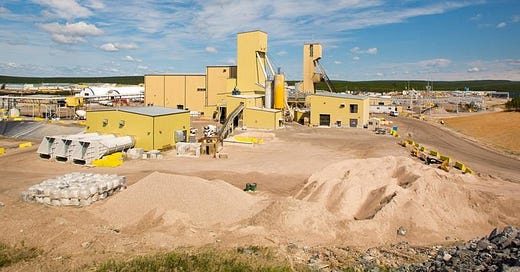As readers are aware, since the start of Golden Rock, we have spent the vast majority of the time covering the fundamentals of the industry across supply, demand, and inventories. These are the three key pieces of information that investors need to understand inside and out to the point that mine production levels or country demand should be in your head and capable of discussing the nuances in any conversation.
Now that we have established our baseline views in the market, it is time to move on to the companies and the ways that investors can express their bullish uranium price views. Let us begin by saying that we cannot possibly get every little detail right on every company. As an investor, it is your job to run your portfolio how you see fit. Only you are truly aware of your views and the types of risk/reward scenarios that you are comfortable taking.
As a result, we want to share some of our contextual views on the mining companies below to give subscribers a flavor for our views as we focus on three key aspects:
Asset(s)
Management
Marketing Strategy
Thus, the goal with this piece is to touch on these three aspects along with why we pay such close attention to certain companies given their production status and ability to swing production higher or lower.
We will cover the following public uranium miners:
Cameco Corporation
Kazatomprom
CGN Mining
Paladin Energy
Boss Energy
Energy Fuels
Encore Energy
Ur-Energy
BHP
Cameco Corporation
Cameco has all three pillars well-covered today and boast any array of assets. On the mining front it is comprised of the following operating mines:
McArthur River (70% Cameco/30% Orano)/Key Lake (83.33% Cameco/16.67% Orano) in Saskatchewan, Canada
Cigar Lake (54.547% Cameco/Orano 40.453%/TEPCO Resources 5%) in Saskatchewan, Canada
JV Inkai (40% Cameco/60% Kazatomprom) in Kazakhstan
Their Tier 2 assets that are currently in care and maintenance are as follows:
Rabbit Lake (100% Cameco) in Saskatchewan, Canada
Crow Butte (100% Cameco) in Nebraska, USA
Smith Ranch-Highland (100% Cameco) in Wyoming, USA
Cameco also owns the several development projects:
Millennium (69.9% Cameco/30.1% JCU (JV between Denison Mines and Uranium Energy Corporation)) in Saskatchewan, Canada
Yeelirrie (100% Cameco) in Western Australia
Kintyre (100% Cameco) in Western Australia
Lastly, Cameco engages in advanced exploration most notably with:
Dawn Lake in Saskatchewan, Canada
Moving down the fuel cycle, Cameco owns the Blind River Refinery (100%) that produces uranium trioxide (UO3) which is transported to Cameco’s 100%-owned Port Hope conversion facility. Lastly, it owns the Cameco Fuel Manufacturing which supplies in-core reactor components for CANDU reactors around the world.
It holds a 49%-owned stake in Westinghouse with Brookfield Renewable whose core business is:
Designs and manufacturers nuclear fuel supplies and services for light water reactors
Provides outage and maintenance services, engineering support, instrumentation and controls equipment, plant modifications, and components/parts to nuclear reactors
Designs, develops, and procures equipment for new nuclear plants (AP1000 and AP300)
Lastly, Cameco owns a 49%-stake in ‘Global Laser Enrichment’ (GLE) which is the exclusive global licensee of the proprietary Separation of Isotopes by Laser Excitation (SILEX) laser uranium enrichment technology. Silex Systems owns the other 51% of the interest in GLE although Cameco has an option to take up its ownership stake to 75%.
Given the auspicious future for nuclear power ahead, we wonder how Cameco is thinking about ultimately replacing ore reserves and it is not clear how aggressive the company feels it needs to be on this front. There is no question that historically, mining companies tend to make acquisitions near the top of cycles causing future write-downs. CEO Tim Gitzel has repeatedly said publicly that they believe today is the most constructive they have ever been on the future of the nuclear industry:
Source: Cameco Corporation, Q1 2025 Earnings Call, Tim Gitzel
As a result, we are closely watching how they are balancing this view with growth opportunities they are implying. Last week, we wrote a short note about is it time for Cameco to think about acquiring NexGen directly or via joint-venture. As readers know, when we laid out our Deep Dive #5: Q2 Base-Case Supply Model, we feel a Cameco/Orano JV could make a lot of sense for both parties.
We also know that Cameco/Orano have another JV at Dawn Lake, where they have been exploring for the last couple years ever since ISO Energy discovered Hurricane deposit just across the Dawn Lake border. Ironically, Cameco sold ISO this ground. But, Cameco/Orano had no idea there was a deposit there until ISO hit a discovery hole and given how close the hole was to the Cameco/Orano property line, they started their own drill program and are hitting mineralization having spent very little capital to find it. So, all in all, it worked out pretty well for Cameco/Orano.
Source: Cameco Corporation, 2024 Annual Report
On the management front, we feel that CEO Tim Gitzel and CFO Grant Isaac have navigated the last ten years of this market brilliantly. If it were not for their leadership during the bear market, the industry would not be in its current position today. Many seem to forget that they were forced to make very difficult decisions to close their Tier 2 assets and ultimately McArthur River/Key Lake while laying off hundreds of employees and costing them capital (even to this day on Tier 2 projects) to keep the assets in a steady state during care and maintenance. While McArthur River was shut down, the company purchased millions upon millions of pounds at levels that were “in-the-money” against their contract book, swung the uranium market balance by an immense amount over these years and kept their pounds in the ground, preserving the value for a later date.
Yet, somehow, many investors seem to think Cameco does not know what it is doing. They repeatedly tell investors exactly what they are doing, which is, seeking full value over the entire cycle.





